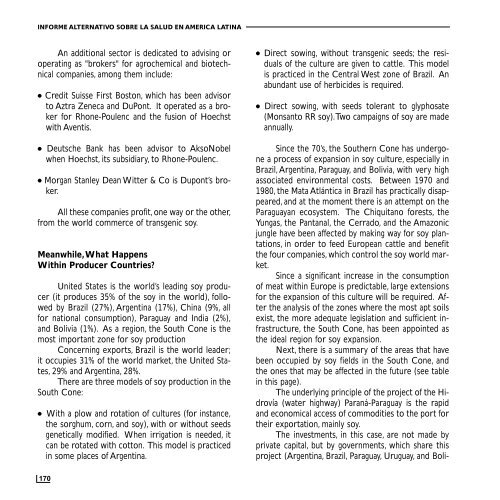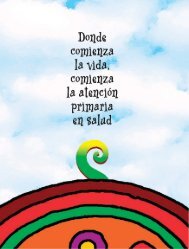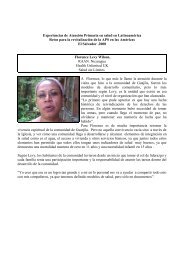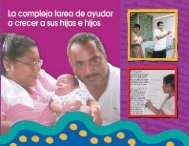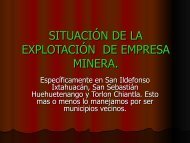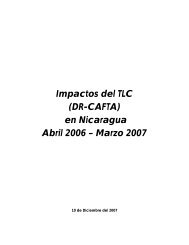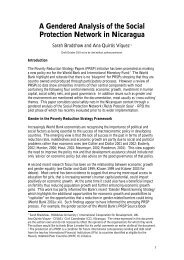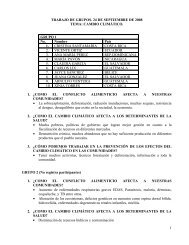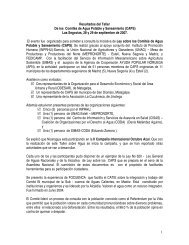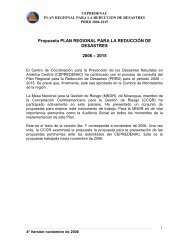Download - CISAS | Centro de Información y Servicios de AsesorÃa ...
Download - CISAS | Centro de Información y Servicios de AsesorÃa ...
Download - CISAS | Centro de Información y Servicios de AsesorÃa ...
You also want an ePaper? Increase the reach of your titles
YUMPU automatically turns print PDFs into web optimized ePapers that Google loves.
INFORME ALTERNATIVO SOBRE LA SALUD EN AMERICA LATINAAn additional sector is <strong>de</strong>dicated to advising oroperating as "brokers" for agrochemical and biotechnicalcompanies, among them inclu<strong>de</strong>:● Credit Suisse First Boston, which has been advisorto Aztra Zeneca and DuPont. It operated as a brokerfor Rhone-Poulenc and the fusion of Hoechstwith Aventis.●Deutsche Bank has been advisor to AksoNobelwhen Hoechst, its subsidiary, to Rhone-Poulenc.● Morgan Stanley Dean Witter & Co is Dupont’s broker.All these companies profit, one way or the other,from the world commerce of transgenic soy.Meanwhile,What HappensWithin Producer Countries?United States is the world’s leading soy producer(it produces 35% of the soy in the world), followedby Brazil (27%), Argentina (17%), China (9%, allfor national consumption), Paraguay and India (2%),and Bolivia (1%). As a region, the South Cone is themost important zone for soy productionConcerning exports, Brazil is the world lea<strong>de</strong>r;it occupies 31% of the world market, the United States,29% and Argentina, 28%.There are three mo<strong>de</strong>ls of soy production in theSouth Cone:●With a plow and rotation of cultures (for instance,the sorghum, corn, and soy), with or without seedsgenetically modified. When irrigation is nee<strong>de</strong>d, itcan be rotated with cotton. This mo<strong>de</strong>l is practicedin some places of Argentina.●●Direct sowing, without transgenic seeds; the residualsof the culture are given to cattle. This mo<strong>de</strong>lis practiced in the Central West zone of Brazil. Anabundant use of herbici<strong>de</strong>s is required.Direct sowing, with seeds tolerant to glyphosate(Monsanto RR soy).Two campaigns of soy are ma<strong>de</strong>annually.Since the 70’s, the Southern Cone has un<strong>de</strong>rgonea process of expansion in soy culture, especially inBrazil, Argentina, Paraguay, and Bolivia, with very highassociated environmental costs. Between 1970 and1980, the Mata Atlántica in Brazil has practically disappeared,and at the moment there is an attempt on theParaguayan ecosystem. The Chiquitano forests, theYungas, the Pantanal, the Cerrado, and the Amazonicjungle have been affected by making way for soy plantations,in or<strong>de</strong>r to feed European cattle and benefitthe four companies, which control the soy world market.Since a significant increase in the consumptionof meat within Europe is predictable, large extensionsfor the expansion of this culture will be required. Afterthe analysis of the zones where the most apt soilsexist, the more a<strong>de</strong>quate legislation and sufficient infrastructure,the South Cone, has been appointed asthe i<strong>de</strong>al region for soy expansion.Next, there is a summary of the areas that havebeen occupied by soy fields in the South Cone, andthe ones that may be affected in the future (see tablein this page).The un<strong>de</strong>rlying principle of the project of the Hidrovía(water highway) Paraná-Paraguay is the rapidand economical access of commodities to the port fortheir exportation, mainly soy.The investments, in this case, are not ma<strong>de</strong> byprivate capital, but by governments, which share thisproject (Argentina, Brazil, Paraguay, Uruguay, and Boli-170


